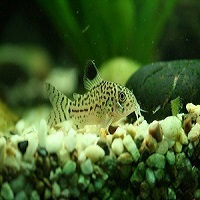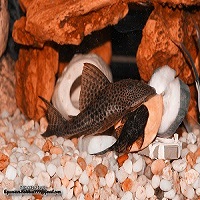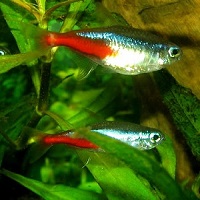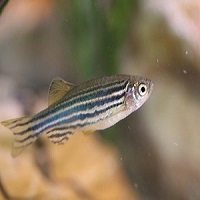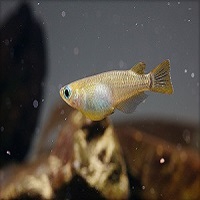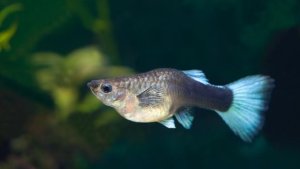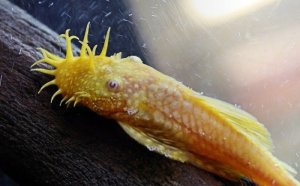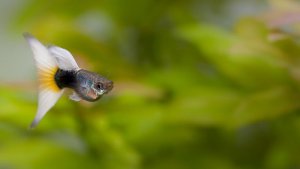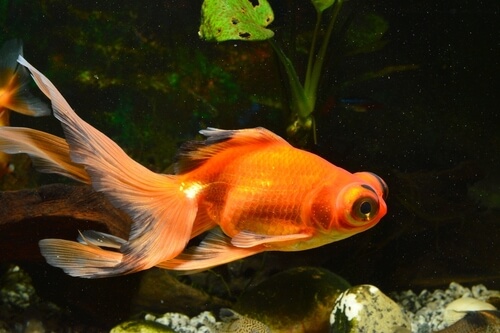
The Butterfly Telescope Goldfish is a unique and exquisite quality Goldfish that falls under the Fancy Goldfish Breeds.
The Butterfly telescope Goldfish is very appealing for most fancy Goldfish enthusiasts, however, does need a bit more effort when it comes to caring, thus it is more suitable for someone with reasonable experience.
If you are interested in this elegant and rare fancy goldfish breed, then we have much more information for you.
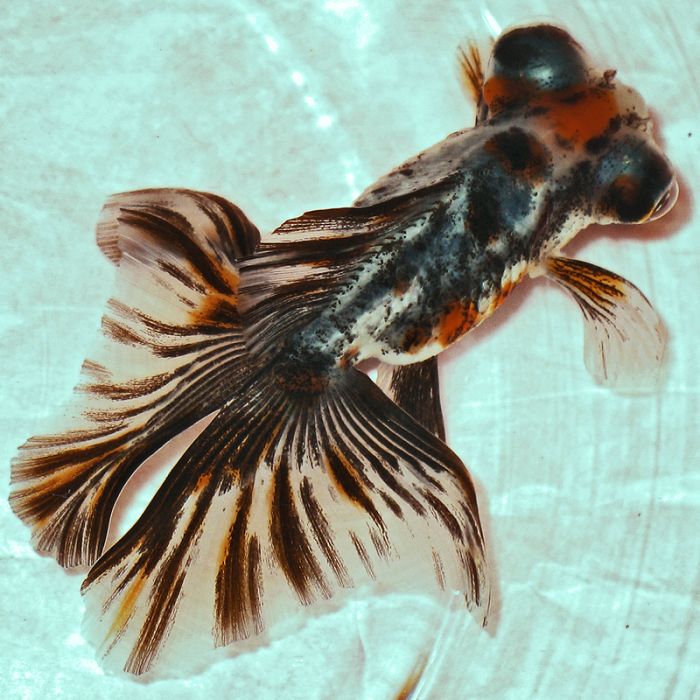
Breed Overview
| Origin | Asia coming from Waterways of Southern China |
| Lifespan | 8 to 10 years |
| Size | Around 6 to 8 inches in a tank and up to 12 inches in a pond |
| Colour | Chocolate, Calico, Orange, White, Red, Black, and Black and White (Panda), Tri-Colored, and Blue-Scale |
| Food | Omnivorous |
| Tank Size | 20-40 Gallons |
| Temperament | Social and do not Shoal |
| Water Type | Freshwater |
| Water Temperature | Around 10-25 Degrees Celsius or 55-77 Fahrenheit |
| Water pH | Neutral PH of 7.0 |
| Difficulty Level | Intermediary |
Species Information
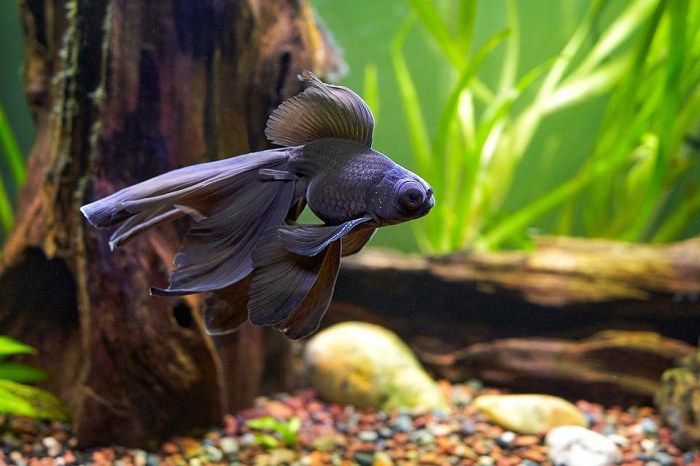
As from the trusted sources of Teichfischer 1994 “The Butterfly Telescope Goldfish is a variant of the Telescope Goldfish that is distinguished by the butterfly-shaped caudal fins when viewed from above”
The variety has only recently been deemed specific reed from a few published works. The telescope Goldfish is well-known for its more protruding eyes, and the tail conformation according to Wikipedia is basically bred from the Butterfly Goldfish into the Telescope Goldfish.
Different Color Variations
The image below shows a regular Butterfly Goldfish, rather than a Telescope, to give you an idea of their more common orange color.
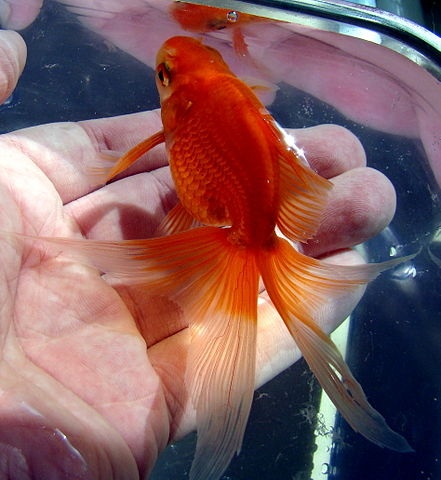
The Telescope Butterfly Goldfish being a rarer species is also available in similar colors to the Butterfly Goldfish;
- Basic orange.
- Red a darker deeper orange.
- Orange or Red and white Tri-Colors and Bi-Colors.
- Black.
- Calico which has lighter markings.
- White.
- Chocolate Brown is sometimes called Iron or Copper.
- Panda which is a black and white color with equal patches resembling a panda.
- Blue Scale which is a much rarer color.
Telescope Butterfly Goldfish Size
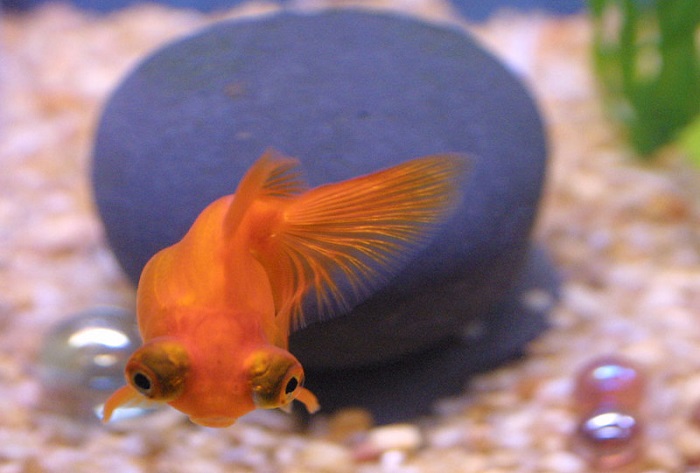
The telescope butterflyfish is a medium to larger-sized fish that is robust and can reach sizes of around 4-6 inches in the right tank conditions. In ponds, there have been claims that they can reach up to 12 inches in size.
General Care
Generally speaking, the telescope Butterfly Goldfish is easy to care for and quite hardy, however, they are very prone to swim bladder. Butterfly Telescope Goldfish likewise also do not do well in water that is too cold.
They are a good choice for pet owners and breeders that have a little more experience with fancy goldfish. They are quite a popular choice among Goldfish enthusiasts as they have a very unique appeal, and are a rarer breed.
So, let’s start off with the basics for caring for your Butterfly telescope Goldfish;
Setting Up Your Tank
The Video below shows a very minimalist tank set-up in which the butterfly telescope goldfish have much freedom to roam;
1. Selecting The Right Sized Tank
The Butterfly Telescope Goldfish requires enough space in the tank with less clutter and more open space for swimming as they are quite active. As they are similar in size to the Oranda Goldfish, also a fancy Goldfish with an easy going temperament, they need around a 20 to 30-gallon fish tank per fish.
You may need to increase the size of your tank for every Goldfish that you want to add by around 20 to 30 gallons.
2. Water Conditions And Filtration
When it comes to getting the right filtration system for your Telescope Butterfly Goldfish, you will need quite a strong filtration system as Goldfish are notoriously messy in general, and can produce plenty of waste in no time.
On the other hand the telescope Butterfly Goldfish is not the strongest swimmer, so you will also need to opt for a filter system such as a canister filter with an adjustable flow, or use a plant or ornament to buffer the current.
You may need an artificial light in your tank if the tank is placed in a shaded area, or to place it in indirect sunlight for Live Plants to survive, and for your fish to have a clear idea of day and night.
Telescope Butterfly Goldfish thrive in cold fresh water; however, according to the Encyclopedia of Aquarium and Pond Fish, “care should be taken, as with other fancy varieties, not to expose them to very low water temperatures”.
The water conditions recommended for telescope Butterfly Goldfish are as follows;
- Temperature between 10-25 degrees Celsius (50-77 degrees F)
- The pH of the water should be neutral pH 7.0.
- Water Hardness needs to be between 5 and 19dGH.
- Nitrates should be around 20 ppm or less.
3. Decorating Your Tank
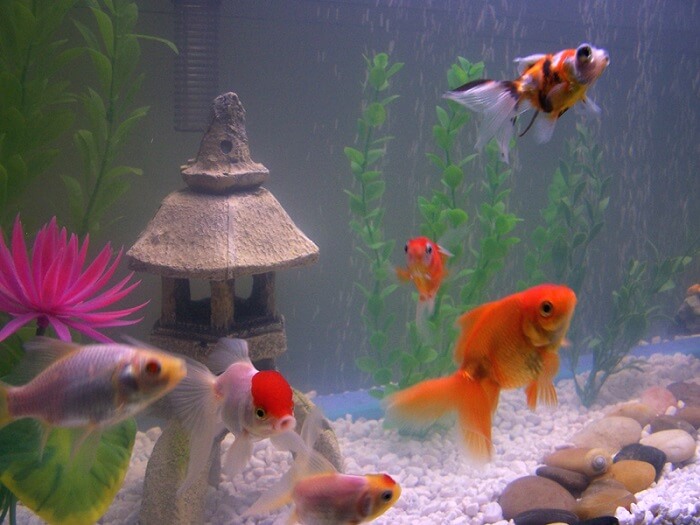
Plants
Plants give a more natural feel to your Goldfish tank and also creates a more comfortable environment for them. You can choose between natural or synthetic plants.
With synthetic plants just be cautious of hard parts that could cause an injury to your fish.
Though Goldfish in general do not essentially require natural plants in their tank, live plants can help to keep the water clean, and in addition do provide oxygen. Some natural plants are edible and many Goldfish do enjoy nibbling on them once and a while.
Good plant options for Telescope Butterfly Goldfish include;
- Java Ferns
- Anubias
- Hornwort
- Marimo Moss Balls
- Bolbitis Ferns
- Floating Plants
Substrate
Although not 100% necessary, it is a much better choice to use a good substrate in your Goldfish tank, as it acts as a filter for dirt and waste, and also as a medium to plant your plants in and place ornaments securely.
When choosing the best substrate for Telescope Butterfly they are a bit more fussy and you may need to follow these cautionary steps;
- The Substrate needs to be smooth in texture as their skin is quite delicate, especially the tail, which in turn has quite a “wide tail spread”
- Most fancy Goldfish are sensitive to pH levels in their tank, especially the telescope Butterfly Goldfish which requires a more specific neutral pH of 7.0. The substrate can affect the pH, so choose a gravel or sand-based substrate.
- Goldfish overall will generally nibble on the substrate in their tank, and the wrong type of substrate could easily cause a digestive issue or more severe consequences. Make sure the substrate that you use is safe.
Decorations
Firstly, you can start off with a background decal of your choices to add some color and a natural feel. Decorations will depend on your style and preferences, however here are a few ideas that you could use;
- You can add more natural driftwood and larger stones.
- Synthetic decorations including Castles, Shipwrecks, or even cars are ideal.
- Bridges and treasure chests are some interesting decorations for your tank.
Though I should warn you when choosing any decorations, be careful that they do not have a rough surface or sharp edges that could injure your Goldfish.
Adding Your New Fish
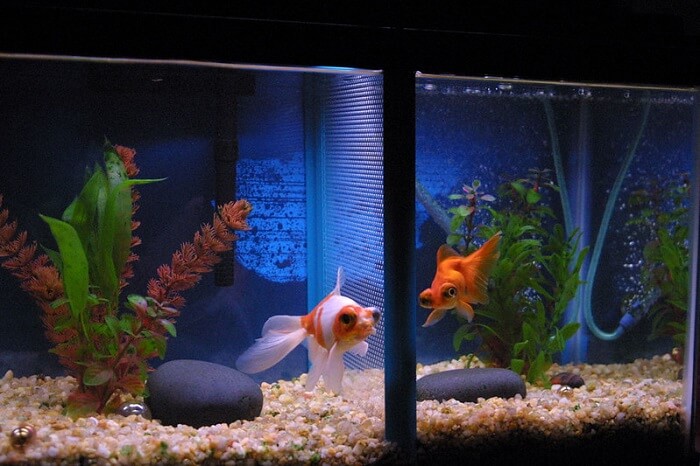
When your tank is finally ready, and you have added your water conditioner to get the right pH, it’s time now to introduce your telescope Butterfly Goldfish to its new home.
However, before we get to that, you need to find a reputable breeder or a good Pet store to find a healthy Goldfish, and tank mates, which we will get into further on, for your tank.
Choosing A Healthy Goldfish
I would suggest that you do a bit of research to find a good fancy Goldfish breeder that has knowledge of this species and that will provide you with a healthy and good quality fish.
Here are a few tips from the Encyclopedia of Aquarium and Pond Fish to help you choose a good specimen;
- The Caudal fin or tail fin should be balanced, and strong and must not droop.
- The Dorsal Fins should be more compact and rounded in shape.
- Telescope Butterfly Goldfish have the Telescope eye trait for telescope fish, with both eyes that are clear and telescopic in shape.
Other than that, generally speaking, any healthy Goldfish should be more active and swimming, and not lethargic.
Placing Your Goldfish In Its New Home
The process of adding any new fish, especially Goldfish to a new tank is much more than just dropping your fish off in the water.
You need to acclimate your fish to their new tank which is a slow process, as you will see from the video, it is a step-by-step explanation to add your new telescope Goldfish to the Tank.
Most of us will not have a separate quarantine tank, and want to acclimate our fish in their original tank which is also fine, though with rare species such as the Telescope Butterfly fish, I would recommend a Quarantine tank, which could also come in handy later if you would like to breed your fish.
So, here are just the basic steps;
- Allow the inside bag with the fish to float on the water for around half an hour to match the temperature.
- Use a cup to scoop some of the tank water into the bag with the fish still allowing it to float.
- Add some of the tank water to the bag every 15 minutes for an hour or two.
- Pour the fish into the tank, but avoid pouring all the water from the bag into the tank.
Selecting Tank Mates
You may want to introduce a few other species as friends for your Butterfly Telescope Goldfish.
The Butterfly telescope fish is a rather gentle species that has wide flowing caudal fins that could easily get damaged by more aggressive species. I would avoid keeping them with more aggressive fish species such as African Cichlids, Oscars or Tiger Barbs.
Most other fancy Goldfish species that can handle similar water conditions are ideal to keep with your Butterfly Telescope fish, then again you could also consider some of these species;
|
Catfish
|
Plecos
|
| Tetras
|
Danios
|
| Ricefish
|
|
Be careful with much smaller fish as the Butterfly Telescope Fish is quite a sizeable fish when fully grown, that could easily swallow small fish.
Tank Maintenance
As most Goldfish species can be quite messy, it is vital to clean and maintain your fish tank regularly to keep the water conditions at peak levels for your fish to thrive.
Here are the steps you need to take for proper maintenance of your tank;
- Remove half of the old water from your Goldfish tank, you will be replacing it with new water.
- Every couple of days to a week, fill a separate container with water, mixing hot and cold to get the right temperatures.
- Add your water conditioner to the water to clean and disinfect the water.
- Add your aquarium salts and ensure that the pH is right, 7.0 neutral.
- Add the new treated water to the tank.
- You can use a tank vacuum or scraper to clean the gravel, sides, and ornaments, or remove ornaments and plants for cleaning.
Feeding
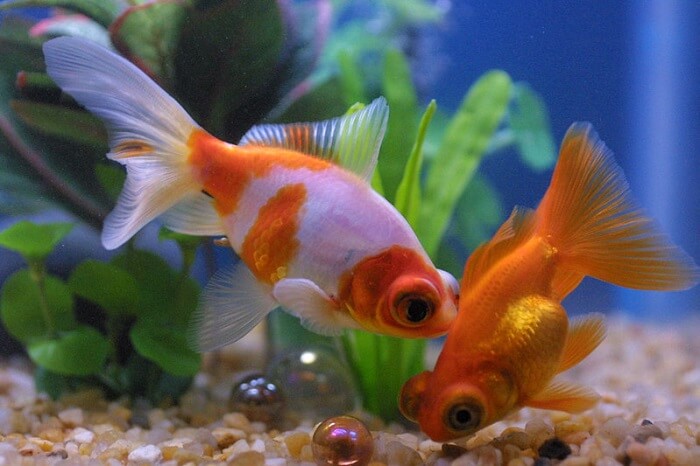
Goldfish are notorious overeaters, and the same fact applies to the telescope Butterfly Goldfish.
You can feed your fish two to three times daily, only enough that they can finish eating. Food that is left over will sink to the bottom of the tank and promote waste causing harmful ammonia build up.
Butterfly telescope Goldfish are Omnivores and therefore require a plant and protein based diet;
1. Flakes And Pellets
High Quality pellets or flakes from a trusted source and brand will be the staple diet of your new goldfish. You can seek recommendations from reputable breeders and from trusted pet stores.
2. Live And Freeze-Dried Foods
As an occasional treat, or depending on the cycle of the Goldfishes’ life, it is good to supplement their diet with freeze dried or live foods. You can offer foods such as daphnia, brine shrimps, bloodworms, insect larvae, and tubifex worms. Just ensure that they come from a trusted source and never feed insects that you caught.
3. Plant Based
Your Butterfly Telescope Goldfish do require some plant matter to thrive, and you may occasionally find them nibbling on the plants in their tank. Aquatic plants and algae are ideal, though you can also offer small amounts of spinach, zucchini, and lettuce.
Temperament And Personality
Though I do not recommend handling your fish unless you are absolutely skilled to do so, you can see from the video how calm and playful Butterfly Telescope fish are.
They are very calm and easy going and relatively easy to care for. They do have specific tank requirements and water parameters, but other than that they are quite low maintenance.
Common Health Issues
As with most fancy Goldfish telescope Butterfly Goldfish are likewise prone to certain health conditions.
- Swim Bladder Disease – you may notice that your Goldfish has some balance issues and starts to bloat, this may be swim bladder disease caused by overeating. Cleaning your tank will help, and getting the water conditions up to optimal levels again.
- Ich – Ich causes small white spots especially on the gill’s of your fish. It is caused by stress and dirty tank, and it is highly contagious, therefore you may need to quarantine the sick fish, and clean your tank.
- Fungal and Bacterial Infections – Fungal and bacterial infections is a common issue in aquarium fish and can be caused by stress and a poor immune system. There are medications that you can get from your pet stores to help with specific Fungal or bacterial infections
- Fin Rot – Fin rot is part of a bacterial infection when the tank water is poor quality. It especially affects Butterfly Goldfish species with their wide tail fins. You need to change at least 25% of your tank water weekly, as mentioned under tank maintenance.
- Physical Damage – Physical damage can easily be caused to the fishes’ body or fins from plants, ornaments, other fish, handling, or even substrate in the tank. You should isolate a severely injured fish in a quarantine tank, and you can use some aquarium salts or even plain non-iodized salt to help heal the wounds.
You can read further on Goldfish Behavior Before Death to get more in-depth insights into Goldfish disease and conditions.
Breeding And Caring For Hatchlings
If you are interested in breeding your Butterfly telescope Goldfish, or Fancy Goldfish, it is a relatively simple process, however you will need a tank to keep the eggs and small fry separately until they are bigger and stronger.
In the video is a simple way to make your own spawning mop and it shows the entire breeding process;
You can follow these guidelines from our trusted Breeding GoldFish source which will be suitable for breeding most types of fancy Goldfish;
Most goldfish species only become mature after one year but they only reach their prime within three years of age. Butterfly telescope Goldfish can be kept in pairs or groups of males and females.
Males that are ready to spawn will form white dots on their pectoral fins and gill covers called tubercles. The females will become heavier on their rear side with more swelling on the left side of the body. The female can lay up to 1000 eggs per spawn.
This makes her capable of laying approximately 500-1000 eggs per spawn.
- The water temperatures need to be cooler for spawning, around 21 degrees Celsius during the day, and 10 degrees Celsius at night. You can add ice or cooler water to the tank to get the right temperatures.
- The females will lay their eggs in plants, and the males will fertilize them or a fish mop as shown in the video that you could make yourself or purchase.
- Do not remove eggs immediately if your fish are resting, as they may not have completed the spawning process.
- The eggs need to be removed to a separate tank where they will hatch within around four to seven days.
- You can remove the spawning mop by turning and shaking it gently.
- Fry can be fed with small baby brine shrimp and a high protein diet until they are older.
An Interesting fact read in the Encyclopedia of Aquarium and Pond Fish is that “many fry will develop with one normal eye and one telescope eye”. Which can make it quite difficult to breed perfect show quality specimens.
Last Thoughts
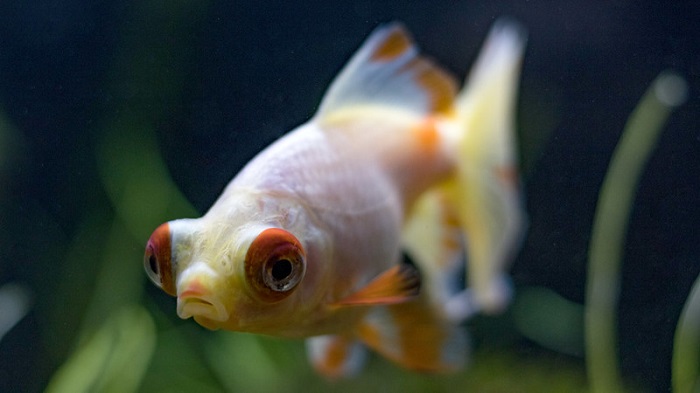
The Butterfly telescope Goldfish is truly an exquisite fancy goldfish breed that is relatively friendly, calm, and has little issues when properly cared for. It can be kept in a tank and pond as it prefers relatively cold-water temperatures as most Goldfish do. The Butterfly telescope Goldfish is also available in some really breath-taking colors.


